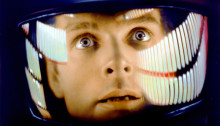What could I possibly write about Kubrick that hasn’t been written before? Today at least… absolutely nothing. And so, in the interests of filling a blank page with some kind of Kubrick-esque blog, here is a series of hurriedly composed haikus, chronologically ordered, on the films of Stanley Kubrick.
Flying Padre: An RKO-Pathe Screenliner (1951)
An early short film
Haven’t seen it. Would like to
An ad for a plane
Day of the Fight (1951)
A boxing doco
Strong frenetic energy
Beginnings of art
Fear and Desire (1953)
Kubrick hated it
Stuck behind enemy lines
Found quite recently
The Seafarers (1953)
Documentary
Lost film until recently
Seafarers Union
Killer’s Kiss (1955)
Film-noir shot with style
Man waits for a train and thinks
First decent feature
The Killing (1956)
Brilliance begins now
Existential noir at track
Money floats in wind
Paths of Glory (1957)
Kirk Douglas at war
Obnoxious generals lie
Human lives wasted
Spartacus (1960)
Kirk Douglas a slave
Rise up against the Romans
I am Spartacus
Lolita (1962)
Nabakov on screen
Humbert Humbert is evil
Foot on camera
Dr. Strangelove or: How I Learned to Stop Worrying and Love the Bomb (1964)
The string in my leg
Precious bodily fluids
This is the war room
2001: A Space Odyssey (1968)
Spake Zarathustra
Open the pod bay doors please Hal.
I can’t do that, Dave
A Clockwork Orange (1971)
Ultra-violence
Beethoven’s Ninth Symphony
Re-education
Barry Lyndon (1975)
Some think it’s boring
Napoleonic era
I think it’s stunning
The Shining (1980)
Overlook Hotel
Some places are like people
All work and no play
Full Metal Jacket (1987)
Private Gomer Pyle
I am in a world of shit
Joker born to kill
Eyes Wide shut (1999)
Tom and Nicole star
Nature of fidelity
The final movie
A.I. (2001)
From beyond the grave
A vision not quite achieved
Tribute from a friend


















Comments
14 responses to “A bizarre and mediocre ode to Stanley Kubrick”
Hi —
Thanks for following my Tarzana blog — perhaps you are Valley people too?
I love these Kubrick haiku–a great synopsis of movies I won’t see, and good use of the form. I’m reminded of Kubrick every day now because of the banners advertising the MOCA show up all up and down Ventura Blvd.!
Coco O.
And I’ve just seen your post on it. Awesome! You’re several steps ahead of me at EVERY turn……. I’ve got my eye on you, guy!!!
Hehe. Loving the hipster jeans piece by the way.
Ah, I love haikus. Lovely post; there’s a documentary out at the moment called Room 237 about how some people have become infatuated with The Shining. They’ve driven themself into insanity by watching it, one chap even interpreting Kubrick’s film to be about his admission that he helped videotape the fake Moon landing footage. Makes for fun viewing!
Glad you like them!
Actually I reviewed Room 237 a little while ago – very interesting film!
Here’s one you may not know: Francis Heaney has written The Holy Tango of Literature, and includes one on Kubrick. “Holy Tango” is an anagram of “Anthology,” and the book includes poems and dramatic sketches, inspired by anagrams of the names of writers. “David Mamet” is transformed into “DAMMIT, DAVE” and folowed by a riff on 2001’s “Open the Pod Door” sequence as it might have been staged by Mamet: http://www.modernhumorist.com/mh/0101/anagram5/
BTW, I’d say:
Eyes Wide shut (1999)
Tom and Nicole star
Glorious career given
Ignominious end
Will definitely check this book out. Thanks!
What an original way to notate Kubrick’s filmography! It fascinates me that he could still make both great and awful films long after being an established director. It must have been the OCD. Some stories require a light touch, and he chose to go over everything ad infinitum once he had creative control. The unbound energy of pictures like The Killing, Strangelove, and Clockwork Orange became less and less possible.
genre worship, I love it
Well done. Haven’t seen all of his movies, but is fun to relate the haikus back to memories of the Kubrick’s I have seen. Well chosen, image dense words, my friend.
Much appreciated 🙂
Not to be that chap, or anything, but surely one of the requirements of the haiku is a reference to nature? Either way, couldn’t agree with you more on Barry Lyndon. Still a pity he didn’t get to make the definitive Napoleon movie.
Wikipedia says…
“Modern Japanese gendai (現代) haiku are increasingly unlikely to follow the tradition of 17 on or to take nature as their subject, but the use of juxtaposition continues to be honoured in both traditional haiku and gendai.”
I know – would have been special. I recently bought this epic hardback of Kubrick’s notes for Napoleon. Made me very happy. Was thinking of it today after a visit to the Napoleon exhibition at the NGV.
Liked the way you organized the stuff… 😀